light Citroen C3 PICASSO RHD 2011.5 1.G Owner's Guide
[x] Cancel search | Manufacturer: CITROEN, Model Year: 2011.5, Model line: C3 PICASSO RHD, Model: Citroen C3 PICASSO RHD 2011.5 1.GPages: 244, PDF Size: 8.29 MB
Page 107 of 244
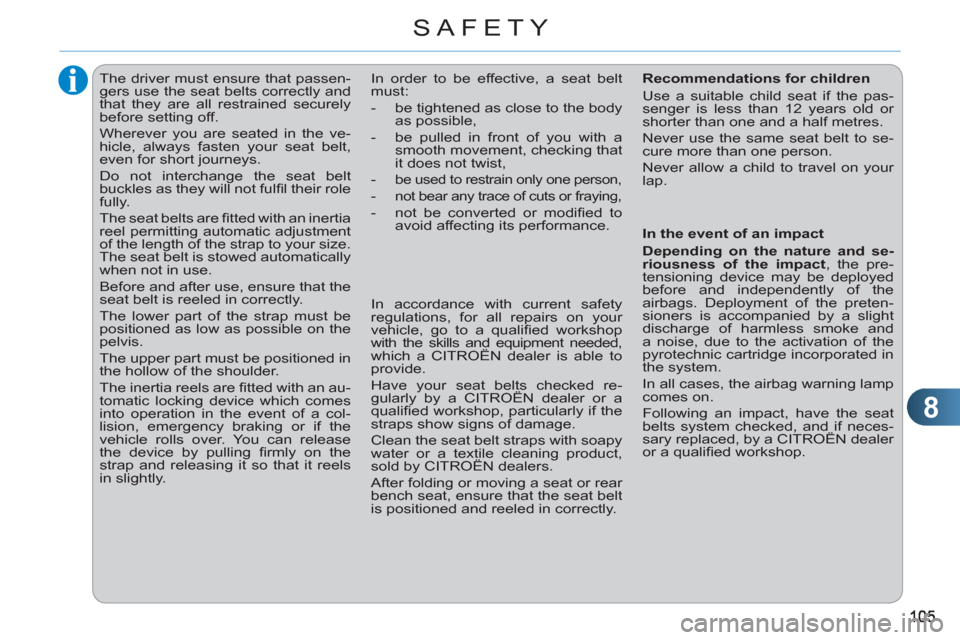
8
SAFETY
The driver must ensure that passen-
gers use the seat belts correctly and
that they are all restrained securely
before setting off.
Wherever you are seated in the ve-
hicle, always fasten your seat belt,
even for short journeys.
Do not interchange the seat belt
buckles as they will not fulfi l their role
fully.
The seat belts are fi tted with an inertia
reel permitting automatic adjustment
of the length of the strap to your size.
The seat belt is stowed automatically
when not in use.
Before and after use, ensure that the
seat belt is reeled in correctly.
The lower part of the strap must be
positioned as low as possible on the
pelvis.
The upper part must be positioned in
the hollow of the shoulder.
The inertia reels are fi tted with an au-
tomatic locking device which comes
into operation in the event of a col-
lision, emergency braking or if the
vehicle rolls over. You can release
the device by pulling fi rmly on the
strap and releasing it so that it reels
in slightly. In order to be effective, a seat belt
must:
- be tightened as close to the body
as possible,
- be pulled in front of you with a
smooth movement, checking that
it does not twist,
-
be used to restrain only one person,
- not bear any trace of cuts or fraying,
- not be converted or modifi ed to
avoid affecting its performance.
In accordance with current safety
regulations, for all repairs on your
vehicle, go to a qualifi ed workshop
with the skills and equipment needed,
which a CITROËN dealer is able to
provide.
Have your seat belts checked re-
gularly by a CITROËN dealer or a
qualifi ed workshop, particularly if the
straps show signs of damage.
Clean the seat belt straps with soapy
water or a textile cleaning product,
sold by CITROËN dealers.
After folding or moving a seat or rear
bench seat, ensure that the seat belt
is positioned and reeled in correctly.
Recommendations for children
Use a suitable child seat if the pas-
senger is less than 12 years old or
shorter than one and a half metres.
Never use the same seat belt to se-
cure more than one person.
Never allow a child to travel on your
lap.
In the event of an impact
Depending on the nature and se-
riousness of the impact
, the pre-
tensioning device may be deployed
before and independently of the
airbags. Deployment of the preten-
sioners is accompanied by a slight
discharge of harmless smoke and
a noise, due to the activation of the
pyrotechnic cartridge incorporated in
the system.
In all cases, the airbag warning lamp
comes on.
Following an impact, have the seat
belts system checked, and if neces-
sary replaced, by a CITROËN dealer
or a qualifi ed workshop.
Page 108 of 244
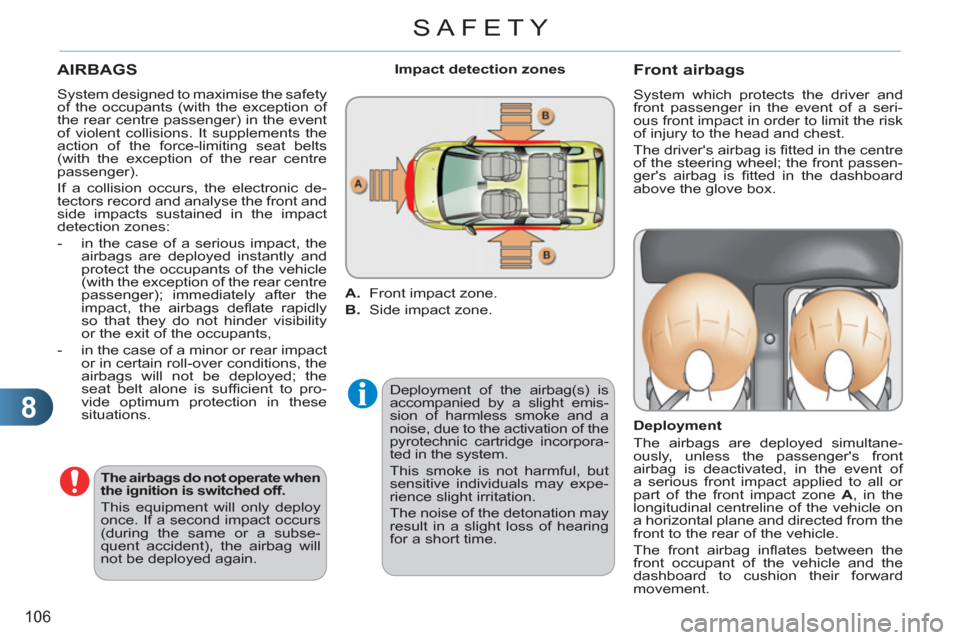
8
106
SAFETY
AIRBAGS
Deployment of the airbag(s) is
accompanied by a slight emis-
sion of harmless smoke and a
noise, due to the activation of the
pyrotechnic cartridge incorpora-
ted in the system.
This smoke is not harmful, but
sensitive individuals may expe-
rience slight irritation.
The noise of the detonation may
result in a slight loss of hearing
for a short time.
Front airbags
System which protects the driver and
front passenger in the event of a seri-
ous front impact in order to limit the risk
of injury to the head and chest.
The driver's airbag is fi tted in the centre
of the steering wheel; the front passen-
ger's airbag is fi tted in the dashboard
above the glove box.
Deployment
The airbags are deployed simultane-
ously, unless the passenger's front
airbag is deactivated, in the event of
a serious front impact applied to all or
part of the front impact zone A
, in the
longitudinal centreline of the vehicle on
a horizontal plane and directed from the
front to the rear of the vehicle.
The front airbag infl ates between the
front occupant of the vehicle and the
dashboard to cushion their forward
movement.
Impact detection zones
A.
Front impact zone.
B.
Side impact zone.
The airbags do not operate when
the ignition is switched off.
This equipment will only deploy
once. If a second impact occurs
(during the same or a subse-
quent accident), the airbag will
not be deployed again.
System designed to maximise the safety
of the occupants (with the exception of
the rear centre passenger) in the event
of violent collisions. It supplements the
action of the force-limiting seat belts
(with the exception of the rear centre
passenger).
If a collision occurs, the electronic de-
tectors record and analyse the front and
side impacts sustained in the impact
detection zones:
- in the case of a serious impact, the
airbags are deployed instantly and
protect the occupants of the vehicle
(with the exception of the rear centre
passenger); immediately after the
impact, the airbags defl ate rapidly
so that they do not hinder visibility
or the exit of the occupants,
- in the case of a minor or rear impact
or in certain roll-over conditions, the
airbags will not be deployed; the
seat belt alone is suffi cient to pro-
vide optimum protection in these
situations.
Page 118 of 244
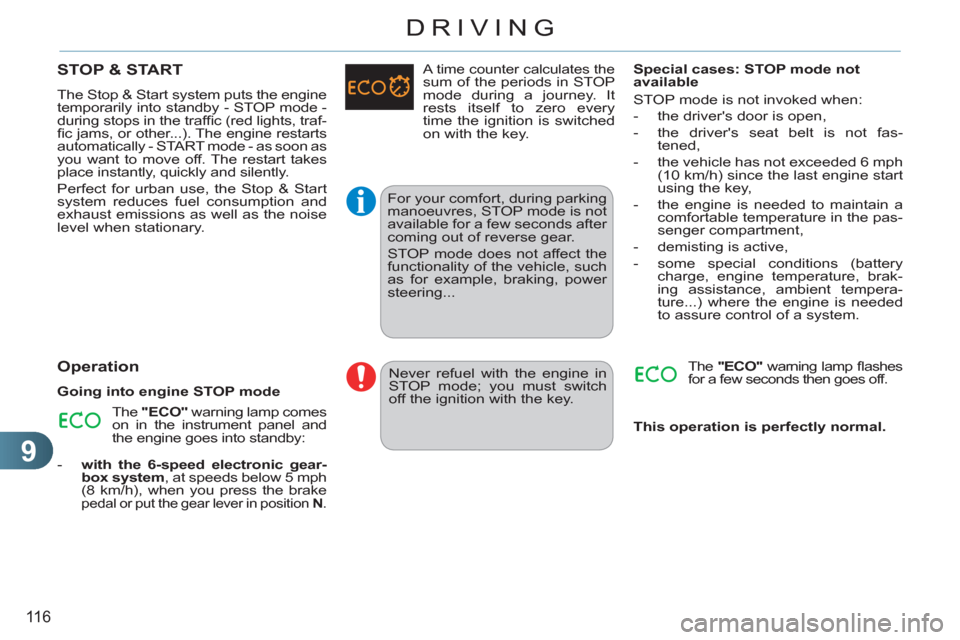
9
116
DRIVING
STOP & START
The Stop & Start system puts the engine
temporarily into standby - STOP mode -
during stops in the traffi c (red lights, traf-
fi c jams, or other...). The engine restarts
automatically - START mode - as soon as
you want to move off. The restart takes
place instantly, quickly and silently.
Perfect for urban use, the Stop & Start
system reduces fuel consumption and
exhaust emissions as well as the noise
level when stationary.
Operation
Going into engine STOP mode
The "ECO"
warning lamp comes
on in the instrument panel and
the engine goes into standby:
- with the 6-speed electronic gear-
box system
, at speeds below 5 mph
(8 km/h), when you press the brake
pedal or put the gear lever in position N
.
For your comfort, during parking
manoeuvres, STOP mode is not
available for a few seconds after
coming out of reverse gear.
STOP mode does not affect the
functionality of the vehicle, such
as for example, braking, power
steering...
A time counter calculates the sum of the periods in STOP
mode during a journey. It
rests itself to zero every
time the ignition is switched
on with the key.
Never refuel with the engine in
STOP mode; you must switch
off the ignition with the key.
Special cases: STOP mode not
available
STOP mode is not invoked when:
- the driver's door is open,
- the driver's seat belt is not fas-
tened,
- the vehicle has not exceeded 6 mph
(10 km/h) since the last engine start
using the key,
- the engine is needed to maintain a
comfortable temperature in the pas-
senger compartment,
- demisting is active,
- some special conditions (battery
charge, engine temperature, brak-
ing assistance, ambient tempera-
ture...) where the engine is needed
to assure control of a system.
The "ECO"
warning lamp fl ashes
for a few seconds then goes off.
This operation is perfectly normal.
Page 149 of 244
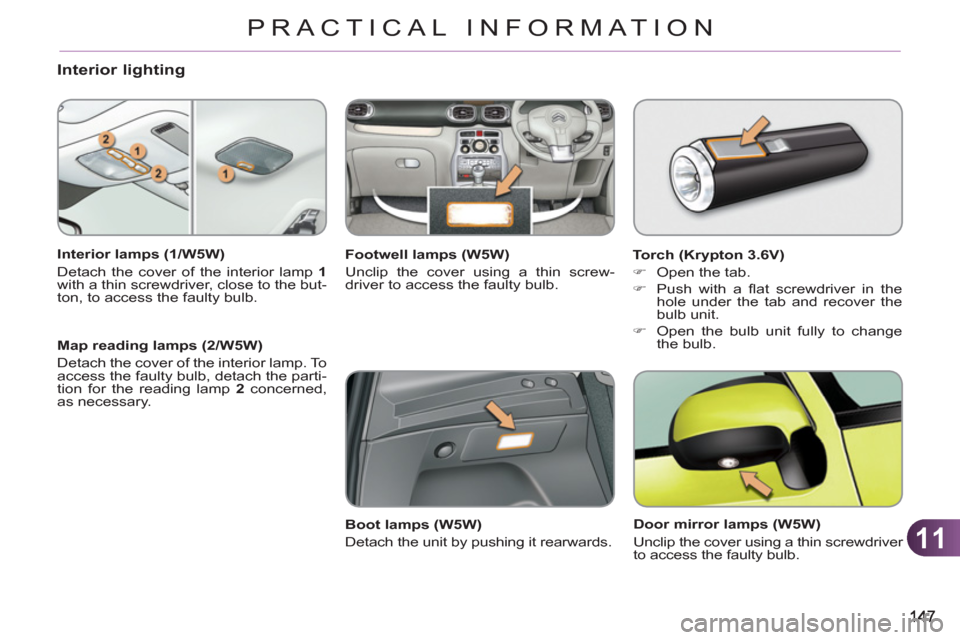
11
PRACTICAL INFORMATION
Interior lighting
Interior lamps (1/W5W)
Detach the cover of the interior lamp 1
with a thin screwdriver, close to the but-
ton, to access the faulty bulb.
Map reading lamps (2/W5W)
Detach the cover of the interior lamp. To
access the faulty bulb, detach the parti-
tion for the reading lamp 2
concerned,
as necessary.
Footwell lamps (W5W)
Unclip the cover using a thin screw-
driver to access the faulty bulb.
Boot lamps (W5W)
Detach the unit by pushing it rearwards.
Torch (Krypton 3.6V)
�)
Open the tab.
�)
Push with a fl at screwdriver in the
hole under the tab and recover the
bulb unit.
�)
Open the bulb unit fully to change
the bulb.
Door mirror lamps (W5W)
Unclip the cover using a thin screwdriver
to access the faulty bulb.
Page 162 of 244
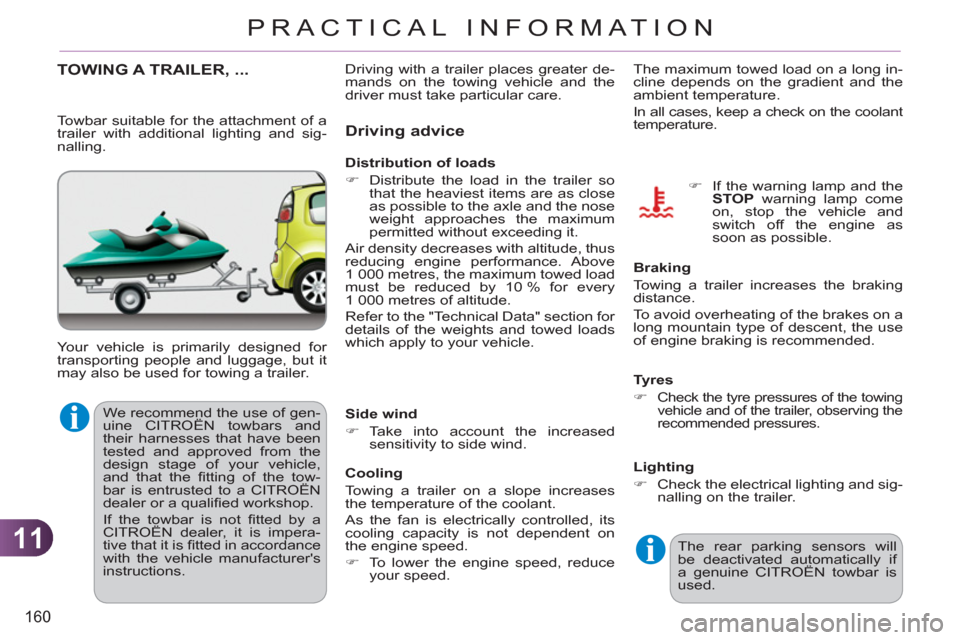
11
160
PRACTICAL INFORMATION
TOWING A TRAILER, ...
Your vehicle is primarily designed for
transporting people and luggage, but it
may also be used for towing a trailer.
Driving advice
The maximum towed load on a long in-
cline depends on the gradient and the
ambient temperature.
In all cases, keep a check on the coolant
temperature.
Side wind
�)
Take into account the increased
sensitivity to side wind.
Cooling
Towing a trailer on a slope increases
the temperature of the coolant.
As the fan is electrically controlled, its
cooling capacity is not dependent on
the engine speed.
�)
To lower the engine speed, reduce
your speed.
Braking
Towing a trailer increases the braking
distance.
To avoid overheating of the brakes on a
long mountain type of descent, the use
of engine braking is recommended.
Tyres
�)
Check the tyre pressures of the towing
vehicle and of the trailer, observing the
recommended pressures.
Lighting
�)
Check the electrical lighting and sig-
nalling on the trailer.
The rear parking sensors will
be deactivated automatically if
a genuine CITROËN towbar is
used.
�)
If the warning lamp and the
STOP
warning lamp come
on, stop the vehicle and
switch off the engine as
soon as possible.
Towbar suitable for the attachment of a
trailer with additional lighting and sig-
nalling.
Distribution of loads
�)
Distribute the load in the trailer so
that the heaviest items are as close
as possible to the axle and the nose
weight approaches the maximum
permitted without exceeding it.
Air density decreases with altitude, thus
reducing engine performance. Above
1 000 metres, the maximum towed load
must be reduced by 10 % for every
1 000 metres of altitude.
Refer to the "Technical Data" section for
details of the weights and towed loads
which apply to your vehicle. Driving with a trailer places greater de-
mands on the towing vehicle and the
driver must take particular care.
We recommend the use of gen-
uine CITROËN towbars and
their harnesses that have been
tested and approved from the
design stage of your vehicle,
and that the fi tting of the tow-
bar is entrusted to a CITROËN
dealer or a qualifi ed workshop.
If the towbar is not fi tted by a
CITROËN dealer, it is impera-
tive that it is fi tted in accordance
with the vehicle manufacturer's
instructions.
Page 167 of 244
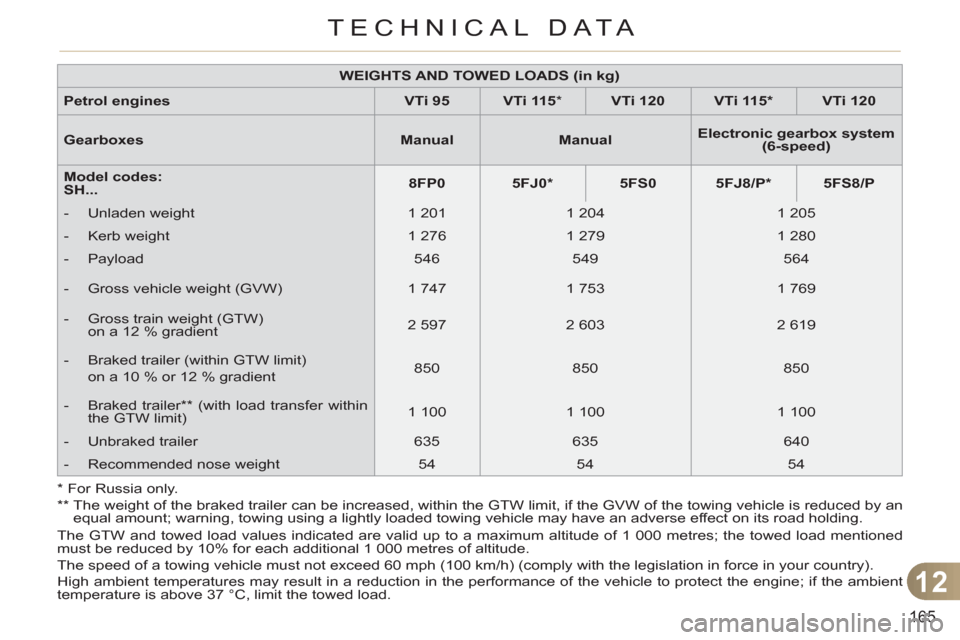
12
165
TECHNICAL DATA
The GTW and towed load values indicated are valid up to a maximum altitude of 1 000 metres; the towed load mentioned
must be reduced by 10% for each additional 1 000 metres of altitude.
The speed of a towing vehicle must not exceed 60 mph (100 km/h) (comply with the legislation in force in your country).
High ambient temperatures may result in a reduction in the performance of the vehicle to protect the engine; if the ambient
temperature is above 37 °C, limit the towed load. *
For Russia only.
**
The weight of the braked trailer can be increased, within the GTW limit, if the GVW of the towing vehicle is reduced by an
equal amount; warning, towing using a lightly loaded towing vehicle may have an adverse effect on its road holding.
WEIGHTS AND TOWED LOADS (in kg)
Petrol engines
VTi 95
VTi 115
*
VTi 120
VTi 115 *
VTi 120
Gearboxes
Manual
Manual
Electronic gearbox system
(6-speed)
Model codes:
SH...
8FP0
5FJ0 *
5FS0
5FJ8/P *
5FS8/P
- Unladen weight
1 201
1 204
1 205
- Kerb weight
1 276
1 279
1 280
- Payload
546
549
564
- Gross vehicle weight (GVW)
1 747
1 753
1 769
- Gross train weight (GTW)
on a 12 % gradient
2 597
2 603
2 619
- Braked trailer (within GTW limit)
on a 10 % or 12 % gradient
850
850
850
- Braked trailer ** (with load transfer within
the GTW limit)
1 100
1 100
1 100
- Unbraked trailer
635
635
640
- Recommended nose weight
54
54
54
Page 169 of 244
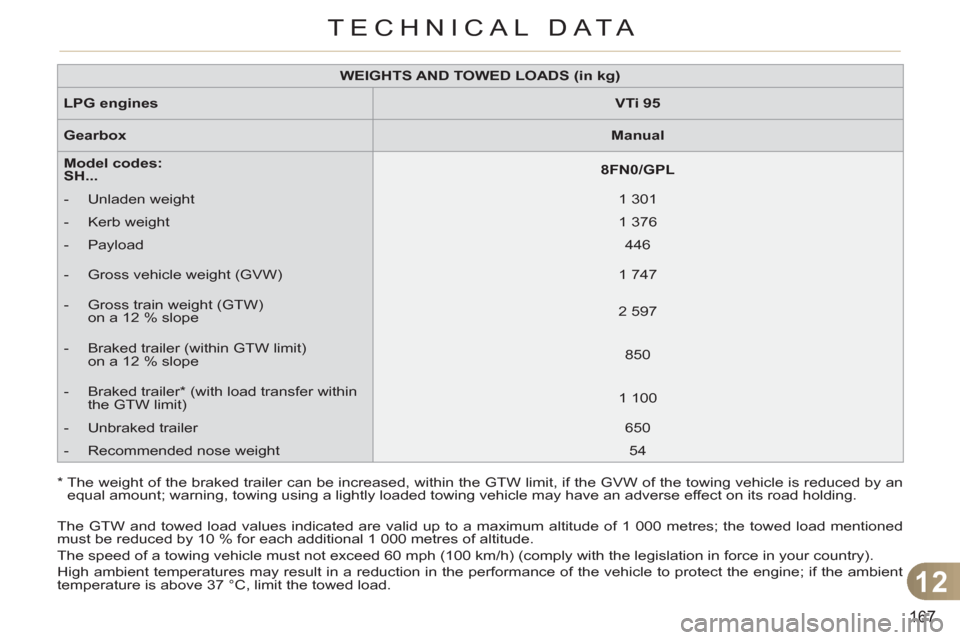
12
167
TECHNICAL DATA
WEIGHTS AND TOWED LOADS (in kg)
LPG engines
VTi 95
Gearbox
Manual
Model codes:
SH...
8FN0/GPL
- Unladen weight
1 301
- Kerb weight
1 376
- Payload
446
- Gross vehicle weight (GVW)
1 747
- Gross train weight (GTW)
on a 12 % slope
2 597
- Braked trailer (within GTW limit)
on a 12 % slope
850
- Braked trailer * (with load transfer within
the GTW limit)
1 100
- Unbraked trailer
650
- Recommended nose weight
54
*
The weight of the braked trailer can be increased, within the GTW limit, if the GVW of the towing vehicle is reduced by an
equal amount; warning, towing using a lightly loaded towing vehicle may have an adverse effect on its road holding.
The GTW and towed load values indicated are valid up to a maximum altitude of 1 000 metres; the towed load mentioned
must be reduced by 10 % for each additional 1 000 metres of altitude.
The speed of a towing vehicle must not exceed 60 mph (100 km/h) (comply with the legislation in force in your country).
High ambient temperatures may result in a reduction in the performance of the vehicle to protect the engine; if the ambient
temperature is above 37 °C, limit the towed load.
Page 171 of 244

12
169
TECHNICAL DATA
*
The weight of the braked trailer can be increased, within the GTW limit, if the GVW of the towing vehicle is reduced by an
equal amount; warning, towing using a lightly loaded towing vehicle may have an adverse effect on its road holding.
WEIGHTS AND TOWED LOADS (in kg)
Diesel engines
HDi 90 PEF
e-HDi 90 PEF
HDi 110 PEF
Gearboxes
Manual
Electronic gearbox
system
Manual
Model codes:
SH...
9HP0
9HP8/P/S
9HR8
- Unladen weight
1 277
1 313
1 318
- Kerb weight
1 352
1 388
1 393
- Payload
502
498
489
- Gross vehicle weight (GVW)
1 779
1 811
1 807
- Gross train weight (GTW)
on a 12 % gradient
2 979
3 011
2 757
- Braked trailer (within GTW limit)
on a 10 % or 12 % gradient
1 200
1 200
950
- Braked trailer * (with load transfer
with the GTW limit)
1 200
1 200
1 200
- Unbraked trailer
675
675
675
- Recommended nose weight
54
54
54
The GTW and towed load values indicated are valid up to a maximum altitude of 1 000 metres; the towed load mentioned
must be reduced by 10 % for each additional 1 000 metres of altitude.
The speed of a towing vehicle must not exceed 60 mph (100 km/h) (comply with the legislation in force in your country).
High ambient temperatures may result in a reduction in the performance of the vehicle to protect the engine; if the ambient
temperature is above 37 °C, limit the towed load.
Page 184 of 244
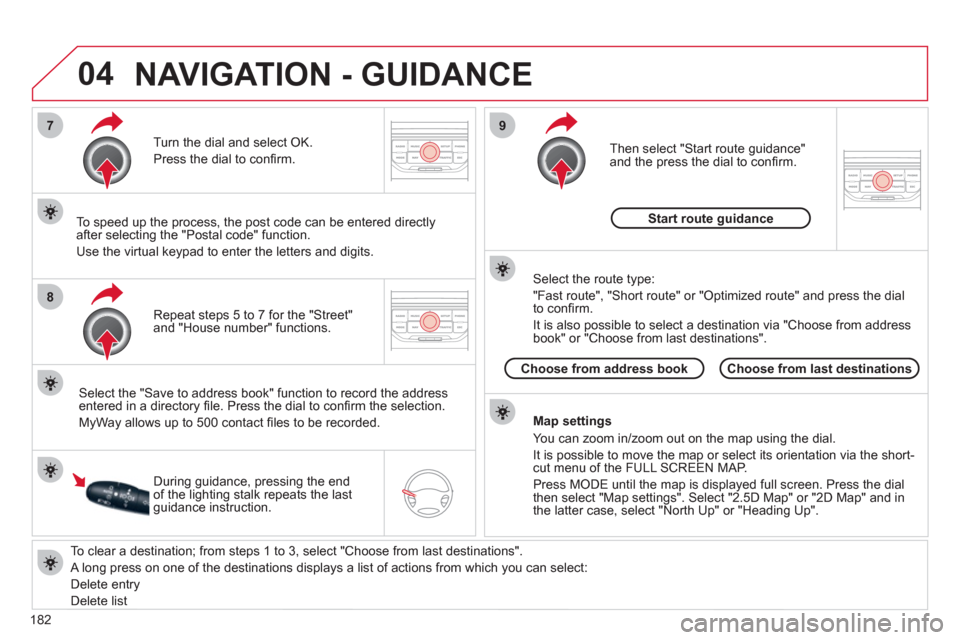
182
04
7
8
9
To clear a destination; from steps 1 to 3, select "Choose from last destinations".
A long press on one of the destinations displays a list of actions from which you can select:
Delete entr
y
D
elete listRepeat steps 5 to 7
for the "Street" and "House number" functions. Turn the dial and select
OK.
Pr
ess the dial to confi rm.
Select the "Save to address book" function to record the address
entered in a directory fi le. Press the dial to confi rm the selection.
M
yWay allows up to 500 contact fi les to be recorded.
To speed up the process, the post code can be entered directl
y
after selecting the "Postal code" function.
Use the virtual ke
ypad to enter the letters and digits.
Then select "
Start route guidance"
and the press the dial to confi rm.
During guidance, pressing the endof the lighting stalk repeats the last guidance instruction.
Map settin
gs
You can zoom in/zoom out on the map usin
g the dial.
It is possible to move the map or select its orientation via the short-cut menu of the FULL SCREEN MAP.
Press M
ODE until the map is displayed full screen. Press the dial
then select "Map settings". Select "2.5D Map" or "2D Map" and in
the latter case, select "North Up" or "Heading Up".
Select the route type:
"Fast route", "
Short route" or "Optimized route" and press the dial
to confi rm.
It is also
possible to select a destination via "Choose from address
book" or "Choose from last destinations".
Choose from last destinations Choose from address bookStart route
guidance
NAVIGATION - GUIDANCE
Page 231 of 244

229
ALPHABETICAL INDEX
A ABS and EBFD systems ............100
Accessories ................................162
Accessory socket, 12 V ....80, 82, 84
Adjusting headlamps ....................74
Adjusting head
restraints ..............................53, 55
Adjusting seat belt height ...........102
Adjusting the steering
wheel ..........................................57
Airbags, curtain ..................108, 109
Airbags, front ......................106, 109
Airbags, lateral ...................108, 109
Air conditioning .............................20
Air conditioning, digital ...........46, 49
Air conditioning, manual .........46, 47
Air fi lter .......................................131
Air fl ow .........................................45
Air vents .......................................45
Anti-lock braking system
(ABS) ........................................100
Anti-pinch .....................................62
Anti-theft .......................................59
Armrest .........................................53
Assistance call ...................100, 174
Audible warning ............................99
Audio streaming
(Bluetooth) ................................219
Audio system ..............207, 222, 224
Automatic illumination
of headlamps ........................71, 73
Automatic operation of hazard
warning lamps ............................99
Automatic rain sensitive
windscreen wipers ................75, 77
Auxiliary
socket .................80, 194, 214, 216B Battery ................................131, 155
Battery, charging ........................156
Battery, remote control ...........60, 61
Blinds ...........................................85
Bluetooth
(hands-free) ......................195, 217
Bluetooth (telephone) .........195, 217
Bonnet ........................................126
Bonnet stay ................................126
Boot ..............................................66
Boot fl oor, adjustable ..............87, 88
Boot lamp .............................79, 147
Bottle holder .................................81
Brake discs .................................132
Brake lamps ...............................145
Brake pads .................................132
Brakes ........................................132
Braking assistance system .........100
C Capacity, fuel tank ........................68
CD MP3 ..............................193, 213
Central locking .......................58, 65
Changing a bulb ..................142-147
Changing a fuse ..................148-154
Changing a wheel ...............138-141
Changing a wiper blade .......77, 157
Changing the date ...36, 198, 220, 221
Changing the remote
control battery ............................60
Changing the time ...36, 198, 220, 221
Checking levels ..................130, 131
Checking the engine oil level ....33, 130
Checking tyre pressures
(using the kit) ............................137
Checks ................................125-132C Children .................. 90-98, 105, 107
Child seats .............................90-97
Child surveillance mirror ...............81
Cigar lighter ..................................80
Closing the boot .....................58, 66
Closing the doors ...................58, 64
Connectors, audio ...80, 194, 214, 216
Coolant level ..............................130
Courtesy lamps ....................78, 147
Courtesy mirror ............................81
Cruise control .............................121
Cup holder ..............................80, 84
D Date (setting) ........36, 198, 220, 221
Daytime running lamps ................73
Deactivating the passenger
airbag .......................................107
Deactivating the rear
windows .....................................63
Deadlocking .................................58
Defrosting .....................................47
Dials .............................................22
Diesel additive level ...................131
Dimensions ................................170
Dipped beam ........................71, 143
Dipstick .................................33, 130
Direction indicators ...............99, 145
Doors ............................................64
Doors emergency control .............66
Driving economically ....................20
E EBA (Emergency braking
assistance) ...............................100
Eco-driving ..................................20
Economy mode ..........................157